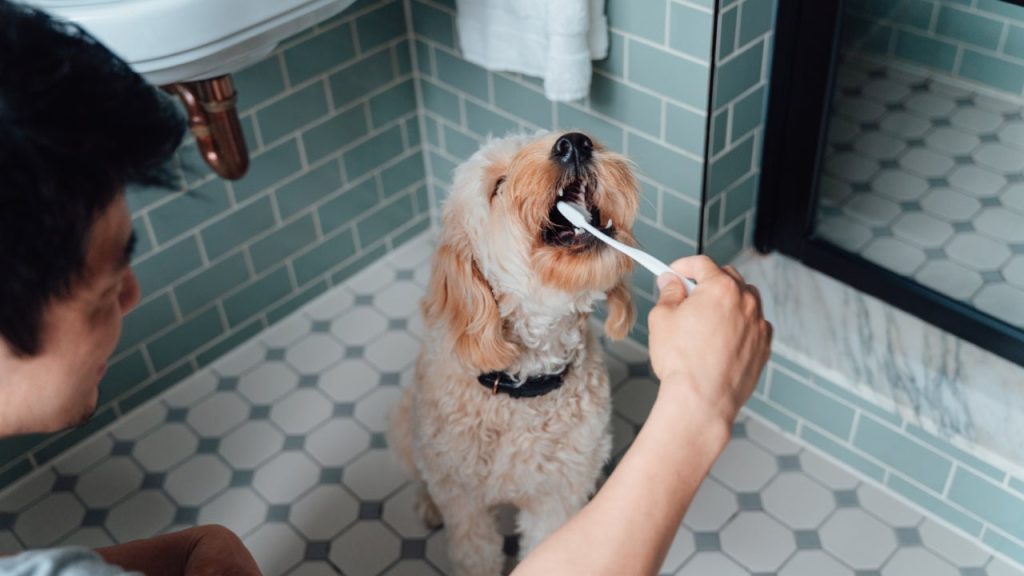Key takeaways
- The American Veterinary Medical Association recommends annual dental check-ups to catch issues before they become problems.
- Toys, treats and daily brushing with pet-appropriate toothbrushes and toothpaste can improve your pet’s oral health.
- Dental care is pricey, but some pet insurances offer cost-saving coverage.
Pet owners want their furry family members to get the right food, regular exercise and lots of love. But there’s one thing you may be overlooking — oral care.
Dogs and cats aren’t known for having minty-fresh breath. But when the odor is extra smelly, there could be an issue with their teeth or gums. Poor dental health may even indicate more serious underlying health problems.
Annual vet check-ups and teeth cleanings to maintain oral hygiene can cost a few hundred dollars per treatment. Luckily, there are things you can do, especially at home, to help save money and keep your pet’s teeth healthy.
Why your pet’s dental health matters
Dental health is an essential component of your pet’s overall health. Just as with human teeth, plaque and tartar can build up. Over time, poor dental hygiene can lead to periodontal disease, tooth loss and other serious health issues, such as infections that spread to the heart, liver and kidneys.
Cats with periodontal disease were 1.5 times more likely to develop chronic kidney disease. At the same time, dogs were 2.3 times more likely to develop chronic kidney disease and 6.3 times more likely to develop endocarditis.
Diseases like these can occur because bacteria from infection enter the bloodstream, affecting the vital organs and causing systemic health issues. Proactive dental care can not only prevent this but also save pet owners from costly treatments down the road.
Common pet dental problems
For humans, dental visits can end with a filling or two (cue the dreaded drill noise). Fortunately, only about 5 percent of dogs and fewer cats have cavities that require filling. Instead, they’re prone to other dental problems, such as periodontal disease.
Periodontal disease develops when tartar and plaque build up. If left unchecked, your pet’s gums can become inflamed, and bacteria can invade the gum line, damaging the teeth and roots. It is the most critical and prevalent dental issue for pets.
It is so prevalent that, over 80 percent of dogs and more than half of all cats begin showing signs of periodontal disease by age three.
Periodontal disease can lead to severe health complications if not promptly addressed, emphasizing the importance of early detection and preventative care. However, there are other common problems to watch for in pets.
- Gingivitis: Also known as stage one of periodontal disease, gingivitis is the inflammation of the gums. Gingivitis occurs when there’s a buildup of plaque and tartar red, leading to swollen gums, bleeding gums and bad breath. It’s prevalent but reversible with proper treatment.
- Malocclusion: Malocclusion is the misalignment of the teeth or jaw. It can cause pain and other oral health problems, such as abscesses or tooth fractures.
- Mouth cysts: Cysts of the mouth are abnormal sacs of fluid that originate from tooth and mouth tissue. Two main types of cysts are dentigerous cysts, which form due to unruptured or impacted teeth, and radicular cysts, which develop due to tooth or root infection.
- Oral infections: Unchecked periodontal disease and trauma to your pet’s mouth are the top two causes of oral infections for pets. Oral infections, such as root and tooth infections, resorptive legions and abscesses, can be very dangerous and lead to bacteremia (bacteria entering the bloodstream) if left untreated.
- Oral tumors: According to the Atlantic Veterinary Internal Medicine and Oncology, benign oral tumors occur in pets, while malignant oral melanoma accounts for 30–40 percent of all canine tumors.
- Tooth fractures: Hard plastic toys and treats like bones or antlers can break your pet’s teeth. These fractures expose the sensitive inner parts of the tooth and often require extraction or root canal treatment.
Home dental health care for your pet
Daily dental care can start at home, with frequent checks of your pet’s mouth for bad breath, red or swollen gums and brownish tartar on their teeth. Below are three more at-home care tips that can help prevent dental issues.
1. Brush your pet’s teeth
As humans, we typically brush our teeth once or twice a day. Your pet’s teeth need similar attention. Brushing their teeth at least three or four times a week, if not daily, is one of the most effective ways to reduce plaque and tartar buildup.
Use a soft-bristle toothbrush or finger brush designed for pets and pet-safe toothpaste. Human toothpaste can contain ingredients that are toxic to pets. Plus, pet toothpaste comes in flavors pets are used to, like poultry, beef and seafood.
Getting your pet to cooperate takes time and patience, but the effort is worth it. Dr. Suma Rao from the University of Illinois Veterinary College says the younger you can start, the better. “First, let the puppy lick the toothpaste from your fingers. Then, introduce a finger brush with paste.” You can then graduate to pet-safe toothbrushes.
2. Opt for effective dental diets and treats
Dry food is a popular go-to for reducing plaque. Some pet food companies even offer special dental care formulas that contain larger kibble, forcing pets to chew rather than swallow the food whole and a special coating to break up plaque and tartar.
Dental dog and cat treats are also great for reducing periodontal disease. Cats especially benefit from dental treats because many cats resist teeth brushing.
Treats are not a one-size-fits-all, though. When choosing dental chews, make sure the treat is size-appropriate for your pet’s mouth and large enough to reach all mouth areas for effective cleaning.
Other pet dental products include water additives, oral gels/sprays and wipes. The Veterinary Oral Health Council even has a list of tested and approved dental products
3. Introduce safe pet dental toys
Dental toys offer hours of entertainment and can also help clean your pet’s teeth. As with dental treats, there are some important factors to consider when choosing a dental toy:
- Look for toys made from natural, durable materials like rubber that are less likely to damage your pet’s teeth from hard chewing.
- Avoid toys that are too hard, as they can cause tooth fractures.
- Find toys with indents or ridges because they are the best for helping clean teeth and massage gums.
Always supervise your pet while playing with dental toys to make sure they do not chew off and swallow large pieces.
When to see the vet for pet dental health concerns
Because most dental diseases begin below the gum line, having a vet or dental specialist check your pet’s teeth and gums is essential to your wellness routine. In addition, Dr. Lynn Happel, director of the American Animal Hospital Association (AAHA), recommends annual teeth cleanings. Pets are placed under general anesthesia during these procedures, while X-rays are taken to help detect dental issues.
Routine visits and annual teeth cleanings are important because pets are masters at masking symptoms, so it’s easy for owners to miss early warning symptoms. Some signs it may be time to seek dental care from your vet include:
- Bad breath
- Broken or loose teeth
- Excessive drooling
- Nasal discharge
- Red, swollen or bleeding gums
- Refusal to eat or drink
- Yellow or brown residue (tartar) on the teeth
What dental care is covered by pet insurance
To the relief of many pet owners, some pet insurances cover the cost of dental care. Teeth cleanings can run anywhere from $500 to $1,000, and extractions can be expensive. Pet insurance helps provide a safety net to manage dental expenses.
You can get pet dental coverage as part of a stand-alone wellness plan or an add-on for pet insurance. Both of these options can help mitigate the costs associated with veterinary dental care, such as:
- Dental emergencies
- Extractions
- Oral surgeries
- Root canals
- Teeth cleanings
With pet dental insurance, you usually pay a monthly premium ranging from $17 to $56 for dogs and $10 to $32 for cats. There are also deductibles and copays. Considering the out-of-pocket costs of dental procedures, the upfront costs of pet dental insurance can save money in the long run.
If you want a pet insurance company that offers dental care, read the fine print carefully to see what is and is not included in your policy.
The bottom line
Like humans, pets require proper dental attention to prevent disease and maintain overall health and well-being. Daily dental care at home, regular veterinarian check-ups and professional teeth cleaning can help prevent tooth loss, bad breath, oral pain and, most importantly, periodontal disease in pets.
Investing in pet insurance with dental coverage can also help reduce out-of-pocket costs for routine oral exams and dental-related emergencies.
Read the full article here












